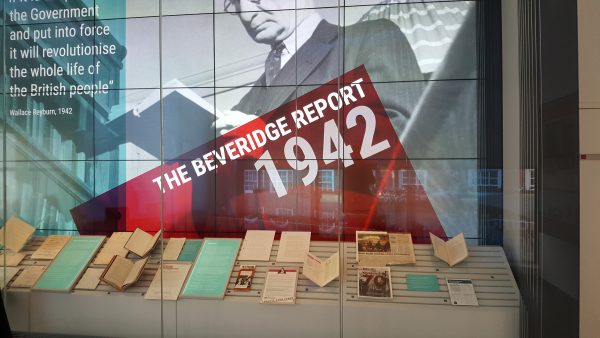Last December marked the 75th anniversary of the Beveridge Report, which laid out the foundations of the modern welfare state, and there’s a small exhibition about the report at the LSE.
Written by the liberal economist, William Beveridge, and officially called Social Insurance and Allied Services, it has always been known by the author’s name.
Commissioned during WW2 by the then coalition government of Tories and Labour, the report looked at how already existing, but modest welfare support could be reformed to deal what he described as being the five evils – squalor, ignorance, want, idleness, and disease.
The significance of the report is easy to see today, but at the time, it was shockingly revolutionary. The role of central government at the time was far smaller than today, but it was the requirements of WW2 that caused it to surge in scope, and in doing so opened up the idea of a much larger role for Westminster in managing society as a whole.
Thus the notion of a larger social security provision to deal with the massive inequalities of the time, the slum housing, the lack of healthcare and the expansion of the pension scheme introduced by the previous Liberal government in 1911.
The report was wildly popular, and over 650,000 copies were printed and sold – an unprecedented number for a government report, and this was also during the middle of wartime austerity.
It was in 1943 that Winston Churchill committed the government to a welfare system “for all classes for all purposes from the cradle to the grave”, although with some restrictions, so it was the subsequent Labour government that introduced a modified version of the report in 1948.
The biggest deviation was that Beveridge recomended heathcare to be provided by local authorities and regional centres, whereas the government, made a power grab for a single national health service that could be controlled by Parliament rather than by — at the time — powerful local authorities.
The exhibition that looks at this dramatic report and the impact it had starts long before the report was written, for momentous changes are usually the result of years of other works before them.
There were “poor laws” already in existence and while many of them were rather patronizing about “the poor” and their low lives, it was felt that a decent society should do something to alleviate the very worst suffering.
This was still the era of small governments, and such matters were often dealt with thanks to philanthropy, as it would have been quite shocking to fund poverty reduction through taxation.
There are a number of documents and books on display from the poor laws through to the publication of the Beveridge Report itself – an early handwritten draft is included — to the reaction by the public, and how later governments dealt with increasing demand for more social services.
A nicety about the reaction to the report comes from Buckingham Palace, inviting William Beveridge to meet the King on 9th December, but offering to find another date if Mr Beveridge found that inconvenient. A polite nothing as doubtless anyone invited to meet the King will never respond asking for the date to be changed as they’re a bit busy.
As an exhibition, it’s light on detailed facts, as there are simply too many to fit into the space, and people’s individual politics will always colour how they read a political display anyway. Therefore, it’s mostly cabinets with rarely seen letters and publications offering a snapshot of how people responded to the idea of central government getting involved in the radical idea of a national welfare state.
The exhibition is a timely, and informative little display.
It’s at the LSE Library and is free to visit. It’s open daily until Friday 13th April.











